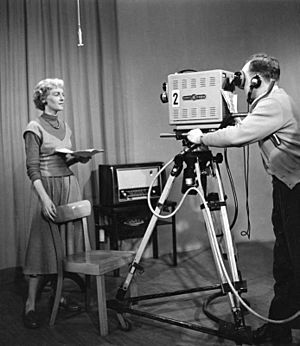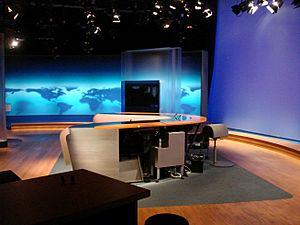Television in Germany facts for kids
Television in Germany started in Berlin on March 22, 1935. It was the first place in the world to have a public TV station, called Fernsehsender Paul Nipkow. This station broadcast for 90 minutes, three times a week.
Germany has a huge TV market. In 2000, about 36.5 million homes had a TV, making it the biggest TV market in Europe. Today, 95% of German homes have at least one TV. All the main German TV channels are free-to-air, meaning you don't have to pay to watch them.
Contents
The History of Television in Germany
After World War II, in 1948, the British forces allowed a TV network called NWDR to start broadcasting in their part of Germany. Other regions soon began their own TV services too. At the same time, East Germany launched its own TV service, Deutscher Fernsehfunk (DFF), which was similar to the TV system in the Soviet Union.
In 1954, all the TV stations that were part of ARD started working together to create a regular TV schedule. They set up rules for shows that would be entertaining, informative, and educational. TV plays also became a special type of art form on television. As technology got better and TV sets became cheaper, more and more people bought TVs. By October 1957, over 1 million homes had a TV license.
A second major TV network, Zweites Deutsches Fernsehen (Second German Television), began broadcasting on April 1, 1963. Unlike ARD, which was made up of many regional stations, ZDF was a single, central TV channel. On August 25, 1967, at 9:30 AM, both ARD and ZDF started showing programs in color. The vice chancellor, Willy Brandt, officially launched color TV in West Germany by pressing a special button at a big TV fair.
East Germany also started a second channel, DFF2, in 1969 and introduced color programs on both its channels. In 1972, DFF changed its name to Fernsehen der DDR (GDR Television) or DDR-FS. Its two channels became known as DDR1 and DDR2.
The first two private TV channels in West Germany, RTL plus and SAT 1, started in 1984. RTL had broadcast from Luxembourg before, but only some parts of Germany could receive it.
After Germany became one country again, the TV stations in East Germany were closed down. Their equipment and staff were used to create new regional networks, like the Mitteldeutscher Rundfunk (Central German Broadcasting), which became part of ARD. Many more private TV channels also started. You could watch them through cable, satellite, and sometimes even over the air.
How the German TV Market Works
Today, Germany has nearly 40 million TV homes and 365 TV channels. This makes it one of the biggest and most varied TV markets in the world. In 2008, the total value of the TV market was over €9.6 billion. Most of this money comes from public funding (money from TV licenses) and advertising. This is why most German TV channels are free to watch.
In 2022, the most popular TV channels in Germany were the two biggest public-service channels: ZDF (with 14.5% of viewers) and Das Erste (with 12.2%). The top commercial channels were RTL (7.4%) and Sat.1 (5.1%). The biggest company for paid TV was Sky Deutschland.
Many German homes (18.1 million) get their TV through satellite dishes. Cable TV is also very popular (17.9 million homes). Only a few homes (3.8 million) use antennas for terrestrial TV. A survey in 2010 found that half of German TV viewers often felt there was nothing good to watch.
Germany is also the biggest market in Europe for dubbing. This means that foreign TV shows are often translated and re-recorded in German. However, watching shows with subtitles (text on screen) in the original language is also becoming more popular.
Popular German TV Channels
Here are the channels with the most viewers in 2022:
| Position | Channel | Owner | Share of total viewing (%) in 2022 |
Share of total viewing (%) in 2011 |
Comparison 2022/2011 |
|---|---|---|---|---|---|
| 1 | ZDF | ZDF | 14.5 | 12.1 | |
| 2 | Das Erste | ARD | 12.2 | 12.4 | |
| 3 | RTL | RTL Group | 7.4 | 14.1 | |
| 4 | Sat.1 | ProSiebenSat.1 Media | 5.1 | 10.1 | |
| 5 | Vox | RTL Group | 4.7 | 5.6 | |
| 6 | ProSieben | ProSiebenSat.1 Media | 3.7 | 6.2 | |
| 7 | Kabel Eins | ProSiebenSat.1 Media | 3.0 | 4.1 | |
| 8 | ZDFneo | ZDF | 2.6 | 0.4 | |
| NDR Fernsehen | NDR/RB | 2.6 | 2.5 | ||
| RTL Zwei | RTL Group | 2.6 | 3.6 | ||
| 9 | WDR Fernsehen | WDR | 2.3 | 2.5 |
The combined share of ARD's regional channels (like WDR, NDR, SWR, etc.) was 13.4% in 2022.
Subscription Channels: What are they?
Subscription channels are TV channels you pay to watch. Germany's main subscription channel, Premiere, was very popular around the year 2000. It used to show games from the German football league, the Bundesliga. But in 2006, Premiere lost the rights to broadcast these games to a new company called Arena.
In 2005, several German cable companies created Arena to compete with Premiere. Arena managed to buy the rights to broadcast the Bundesliga, which was a big deal in German TV. This was a major setback for Premiere. Arena held these rights from 2006 to 2008.
Public Broadcasters in Germany
As we learned, ARD was the first German broadcasting station. It's set up in a way that includes many regional broadcasters. Currently, nine regional public broadcasters work together to create programs for the main TV network called Das Erste (The First):
- Norddeutscher Rundfunk – North German Broadcasting – for Hamburg, Lower Saxony, Schleswig-Holstein, and Mecklenburg-Vorpommern.
- Radio Bremen – also a TV broadcaster – for Bremen.
- Rundfunk Berlin-Brandenburg – Berlin-Brandenburg Broadcasting – for Berlin and Brandenburg.
- Mitteldeutscher Rundfunk – Central German Broadcasting – for Saxony, Saxony-Anhalt, and Thuringia.
- Westdeutscher Rundfunk – West German Broadcasting – for North Rhine-Westphalia.
- Hessischer Rundfunk – Hessian Broadcasting – for Hesse.
- Südwestrundfunk – South Western Broadcasting – for Baden-Württemberg and Rhineland-Palatinate.
- Saarländischer Rundfunk – Saarland Broadcasting – for Saarland.
- Bayerischer Rundfunk – Bavarian Broadcasting – for Bavaria.
Seven of these broadcasters also have their own regional TV programs, often called The Third programs. They sometimes have different versions for local areas. For example, BR and WDR have regional opt-outs for specific parts of their states.
The smaller regions of Bremen (RB) and the Saarland (SR) have their own broadcasting stations. They help create programs for the national channel Das Erste and also produce local programs for their neighboring broadcasters.
Teletext: Text on Your TV Screen

Germany has had a regular Teletext service (often called Videotext) since June 1, 1980, on its public TV channels. Almost all German TV stations have teletext. Even with the rise of digital TV, teletext is still used a lot.
You can choose teletext pages using a three-digit number, from 100 to 899. While each station can organize its pages differently, most follow a common setup:
- 100: Main page
- 110: News
- 120: News / Weather
- 200: Sports / Soccer
- 300: TV schedule
- 333: What's on air right now
- 600: Advertising, chats (only on commercial channels)
The teletext system is also used to send subtitles. These subtitles appear on a special, clear page (usually 149, 150, or 777), so you can see both the text and the normal TV picture. However, with digital TV, some stations now use the subtitle feature of the Digital Video Broadcasting (DVB) system instead of teletext.
Popular German TV Series
Most fictional shows on German television are TV series that run regularly. Public broadcasters often create their own shows. Private channels, however, often buy and show series from other countries, especially the United States. In the 1990s, private channels had many successful self-produced series like Der Clown (1996–2000) and Alarm für Cobra 11 – Die Autobahnpolizei (since 1996). But since the late 2000s, private broadcasters have made fewer original series.
The most popular series is the crime drama Tatort. It airs almost every Sunday on the public broadcaster ARD. This show has been running since 1970 and features different groups of characters in different cities, who are not connected to each other.
See also
 In Spanish: Televisión en Alemania para niños
In Spanish: Televisión en Alemania para niños
- Telecommunications in Germany
- List of television stations in Germany
- List of German language television channels
- List of German television series
- German television comedy
- Media of Germany
- Dubbing (filmmaking) § Germany, Austria and Switzerland




